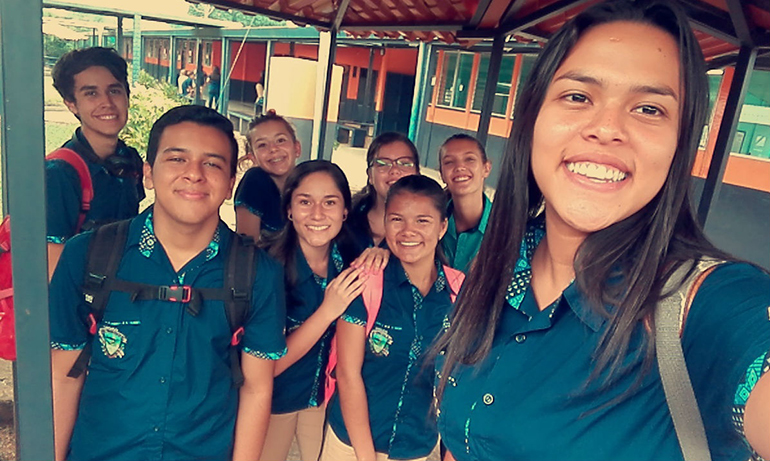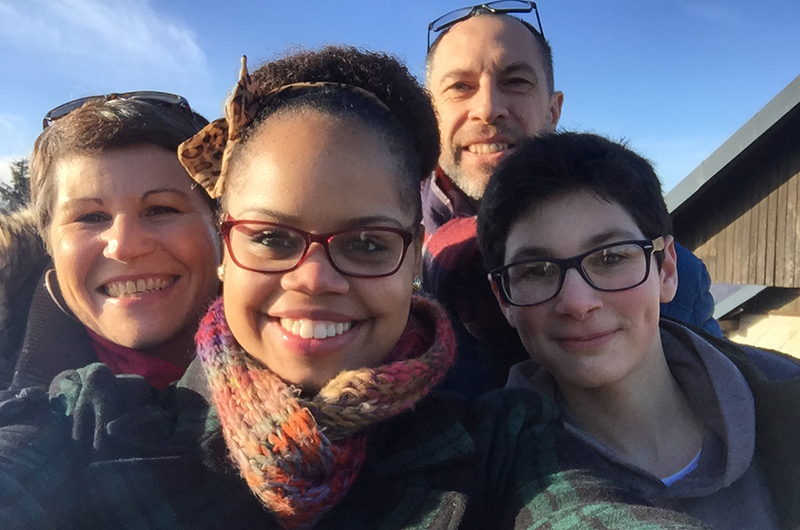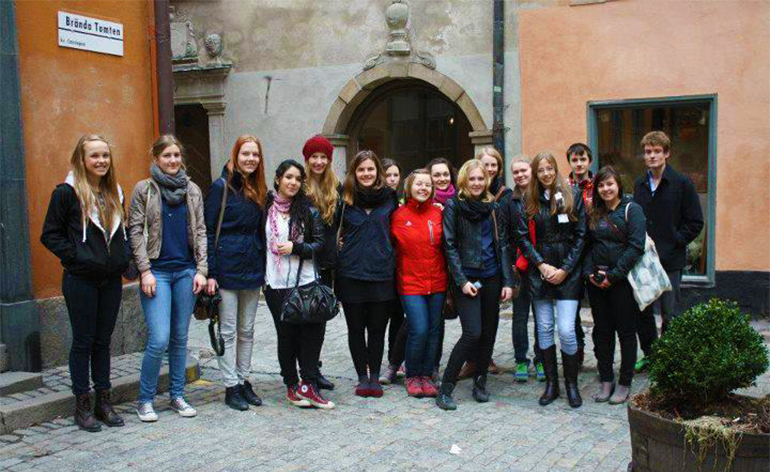Before the pamphlet even touched her hands, Leah Miller’s mind was thousands of miles away, imagining life as a high school exchange student in a foreign country.
Leah’s inspiration to study abroad was sparked by a Greenheart Travel team member who visited her high school in rural Michigan. As a junior in school at the time, Leah was seeking adventure, challenge and ways to feed the curiosity blooming inside her while still being able to graduate with her fellow classmates.

Interest in Studying Abroad Increases While High Schools Slow to Show Support
International education is nothing new. For hundreds of years, people have been traveling to foreign countries to learn new languages and observe other cultures while attending school. What is new is the changing demographic of people who go abroad and their growing amounts.
Although less than in many other countries (fewer than 1 in 10 U.S. students study abroad), the last decade has seen a continuous increase in the amount of university students studying abroad from the U.S., with numbers more than doubling since 1998. As this number rises, high schoolers have not refrained from joining the trend.
Unfortunately, despite an increase in high school students interested in studying abroad, high school systems are still working to catch up to offer support. Without systems in place for transferring international class credits, a lack of understanding from teachers or guidance councilors and the threat of delayed graduation, many students find they have to wait until university for their chance to live and study abroad.

¨I wanted to go for a year,¨ Leah explains, referring to her wishes to study Spanish and the local culture of Costa Rica during a high school exchange program. ¨I asked [my school counselors], ‘If worst comes to worst, and I can’t transfer any credits I get in Costa Rica, can I still graduate?’ That was the reason I only went for five months, [ ] so that I could still graduate.¨
Although Leah praises her teachers for their support and eagerness to help, she was only the third person in her school’s history to study abroad, and navigating academic credits between countries was uncharted territory.
Finding Solutions to Transferring International Class Credits
Leah is not the only student who has encountered issues transferring credits from her time abroad. Differing curriculums and school systems between countries make it hard for schools to know whether or not the classes taken abroad are the equivalent of what would be taken in the home country, and if the credits should therefore count at all.
Schools are typically supportive of the idea of cultural exchange. When students are able to study abroad, they return with a greater sense of independence, clearer academic goals and a better understanding of the global community. All positive traits to have as a student, but the nature of transferring credits remains the main obstacle of putting ideas into action. The possibility of having to repeat a year, or, like in Leah’s case, graduating with a different class, tends to be enough to turn students away.
My Personal Experience Studying Abroad with the Help of a Supportive School System

Before leaving for my own ten-month high school program in Costa Rica, there was ambiguity and an abundance of questions regarding my ability to transfer credits. I was told that whether or not I would receive grades depended on my school in Costa Rica, and that I could only get answers once I arrived in the country.
Although my Costa Rican high school’s ability to help with class credits was based off of luck, it was reassuring to know that my hometown school, Lincoln High School in Portland, Oregon, was willing to do all they could to ensure I would graduate on time. Lincoln High School has managed to make going abroad a more accessible possibility for students. By offering and accepting a larger variety of classes that meet graduation requirements, Lincoln has worked with the Portland Public School District to simplify the process of transferring credits.
Kara Wendel, who is approaching her eighth year of teaching freshman and junior English at Lincoln High School, explains that the school views cultural exchange as ¨a way to better one’s self academically, rather than interrupting four years of high school.¨

Outside of traditional exchange, she estimates that teachers, particularly in the language department, spearhead at least two to three trips abroad each year.
This is good news, but fails to affect the thousands of students across the United States who do not live in Portland.
It takes time for schools to change their curricular requirements, and the obstacles that interfere with smooth academic transitions after going on an exchange may seem daunting. Regardless, the benefits of engaging in other cultures are worth the challenges and frustrations. As a study abroad alum herself and having visited about 20 countries (she lost the exact count), Wendel sees the positive effects of traveling both in herself and the students she teaches.
The Benefits of Studying Abroad in High School

¨Socially, [the students] seem to be more open to meeting people,¨ she says. ¨[They are] willing to talk to someone and not be afraid of the social risk. I also think that they are a little more in tune to world events because of the travel experience.¨ Wendel continues that students are often ¨able to see from a point of view that they couldn’t see from before.¨
I can personally attest that my social skills have improved since my time abroad, but that the changes also go beyond what is easily noticeable to those around me. I have adapted healthier methods for stress management, and have learned to use more efficient study techniques.
With more than one language under my belt and an enhanced interest in the world around me, I feel more compelled and prepared to explore new countries and learn from their cultures. For these reasons, and the beautiful relationships and memories created through travel, thousands of exchange students find the value in seeking what exists beyond our comfort zones each year.
Every moment of awkward confusion, misunderstanding, homesickness, or hoop you must jump through to engage in other cultures is worth it a million times over.
For students like Leah, who have little control over the challenges that hinder them from studying abroad, you have more options. Don’t let your first challenging obstacles or lack of support keep you from experiencing the world around you. From adjusting the length of a study abroad program, to summer exchange opportunities and local events, there are a number of ways to pursue your dreams of living and studying abroad.

Embark on a Summer or Short-Term Exchange Program
No matter the length, any time spent immersed abroad is worthwhile. Even if only for a month, the results from exposure to other cultures and languages are impossible to replicate.
Thankfully, many organizations that specialize and offer support in studying abroad, also offer shorter length academic or summer language programs. From a few weeks to a few months, you can find exchange opportunities that fit within a workable time period to help avoid conflicts with your school.
Greenheart Travel conducts trimester high school exchanges, as well as 1 -2 month programs for select countries during your summer break or school year. Both of these choices can be helpful if you must make up credits upon returning to your home country, as the workload will be more manageable. You can also look into taking online courses while abroad to stay on track.
If you choose to take a shorter length trip and your school is still hesitant about transferring credits, contact the organization you plan to go abroad with and they can likely speak with your counselors to offer example school curriculums and discuss possible credit transfers.
If you do high school abroad programs in Argentina, Costa Rica or New Zealand in June, July or August, you won’t have to worry about transferring credit!
Consider Attending a Language Camp

This option has a similar format to a traditional study abroad, with participants living with a host family and experiencing complete language and cultural immersion, but is shorter in length and focuses specifically on learning the language.
Greenheart Travel offers summer language camps, which allow you to become immersed in another culture while taking about 15-20 hours of language classes per week. Depending on the country you choose to study in, there is often little to no prior knowledge of the language required. Those familiar with the language can prepare to perfect their skills in a fluent environment, while beginners can expect notable progress (paired with the notable discomfort of language barriers).
When living in Germany for a month, Wendel found that her lacking comprehension of the language played into the growth she underwent. ¨Germany was good because I didn’t speak the language, but I had to learn how to try and communicate in other ways when I couldn’t [talk].¨
Being pushed beyond your comfort zone in this manner fast-tracks your language skills, as well as your ability to connect and interact with people through ways other than just words.

Engage in International Service Learning Opportunities or Volunteer Abroad
Volunteer trips abroad vary in length, but are often shorter and available during summer and other seasonal breaks. Programs can be found through exchange organizations, and may be provided by local nonprofits or churches, too. Greenheart Travel offers individual teens the opportunity to volunteer in Costa Rica and Sri Lanka, and established teen groups can head together to Costa Rica, Sri Lanka, Thailand, Australia or Puerto Rico.
Volunteering is a hands-on way to not only learn about and observe another culture, but make an impact in the process. These often action-packed programs present a lot of cultural exposure in a shorter amount of time, and, like studying abroad, can open your eyes to entirely new perspectives and experiences. See here for group trip information.
Get Involved in a Student Union
Leaving the country is not always an option, but, thankfully, there are many local opportunities to experience and learn about other cultures.
¨We are starting to have more student unions around,¨ states Wendel. She adds that MEChA (Movimiento Estudiantil Chicano de Aztlan), the Hispanic and Latino student union at Lincoln, has ¨created a lot of opportunities for people to come and learn about [the] culture.¨
Although it is not the same as traveling abroad, sharing customs sparks cultural conversations and is a powerful way to build relationships. Student union meetings can present a variety of opportunities, including potlucks featuring traditional dishes, or, like in MEChA, sugar skull decorating parties.
If there are no student unions at your school or within your community, contemplate creating your own. You are likely not the only one who could benefit from bringing people together to share their values and heritages.

Seek Out Local Cultural Activities in Your Community
Depending on where you live, there may be local restaurants, theaters or markets that celebrate diverse cultures through exhibitions or events. You might be surprised by what you can find on the shelves of a French market, or what you can learn about your fellow community members at a concert featuring an Argentinian band.
Ask around or look online to see if there are any nearby showings of films in other languages or movies produced by people from other countries (this is also a great way to support international film!). You may be able to find cross-cultural restaurants, too.
As a way of meeting my Spanish teacher’s requirement to attend a certain amount of cultural events each semester, a friend and I went to a concert by a band called Son de Madera. This son jarocho band from Veracruz, Mexico brought together an astounding array of people with varying styles and languages at the single venue. The unique form of music they performed, fusions of cultures they expressed through their art, and the melting pot of people who attended were all key parts that made the experience so impactful for me and my friend.
These activities can not only expose you to new languages being spoken by native speakers, but also show you pieces of other cultures without leaving the country.
Think Globally, Volunteer Locally

Search your area to see what volunteer options pertaining to other cultures are available, and do not shy from getting creative.
After being asked about alternative methods students use to engage in other cultures, Wendel mentions the increasing popularity in helping immigrants gain their U.S. citizenship. On top of helping people study U.S. history for the citizenship test, students are learning from others with diverse backgrounds and experiences.
¨That’s cultural exchange,¨ Wendel says. ¨They’re learning about where these people have immigrated from and what challenges they’re facing, so I think that’s another way that students are engaging through volunteerism.¨
You can log your volunteer hours and connect with other volunteers on the Greenheart Club, and apply for Greeneheart service grants!
Host an Exchange Student

Cultural exchange during a study abroad trip is a two-way street, meaning that not only does the exchange student get an immersive experience in another culture, but the host family gets a taste of the student’s heritage as well.
While studying abroad in Costa Rica, I was able to create strong connections with my host family through sharing parts of my culture with them. From cooking meals commonly eaten at my home in the U.S. to showing them pictures of my city and the state I come from, all of us were able to gain insight into other lifestyles and laugh at our comical differences in customs.
Hosting an exchange student here in the United States is another way to learn about global communities when you aren’t able to travel abroad.
When stripped down to its core, I believe the primary purposes of studying abroad are to share cultures and learn how to bond over our differing practices and values. Exploring other countries is the standard method of progressing towards achieving this, but travel is not the only option.

No matter what stands between you and an international exchange program, be it difficulty transferring credits or other issues unique to your situation, consider how other options can help you navigate through your current roadblocks. There is no one perfect way to travel abroad, and the possibilities (even the ones less thought of) are there to be taken advantage of. From short length or summer exchanges to attending local events, restaurants or markets, engaging in other cultures does not have to be a distant aspiration, but a present reality.
Our distinct histories and heritages do not stop at borders; they can be found in our communities and the people who build them. The eye-opening capabilities of studying in another country are impossible to replicate, but the value of celebrating cultures and finding ways to unite in them can be cherished no matter where you find yourself in the world.

I appreciate you sharing, very good read – read through it from start to finish along with to comment here to let my views be identified on the subject.